AMD Launches Mobile Kaveri APUs
by Jarred Walton on June 4, 2014 12:01 AM ESTAMD Kaveri FX-7600P GPU Performance Preview
Given the 3DMark results we just showed as well as the increase in CPU performance, I was very interested to see what Kaveri could do in terms of gaming performance. Here I have to temper my comments somewhat by simply noting that the graphics drivers on the prototype laptops did not appear to be fully optimized. One game in particular that I tested (Batman: Arkham Origins) seemed to struggle more than I expected, and there are other games (Metro: Last Light and Company of Heroes 2) that will bring anything short of a mainstream dGPU to its knees. I've posted the Kaveri Mainstream and Enthusiast scores in Mobile Bench, but they're not particularly useful as most of the scores are below 30 FPS. Here, I'll focus on our "Value" settings, which are actually still quite nice looking (Medium detail in most games).
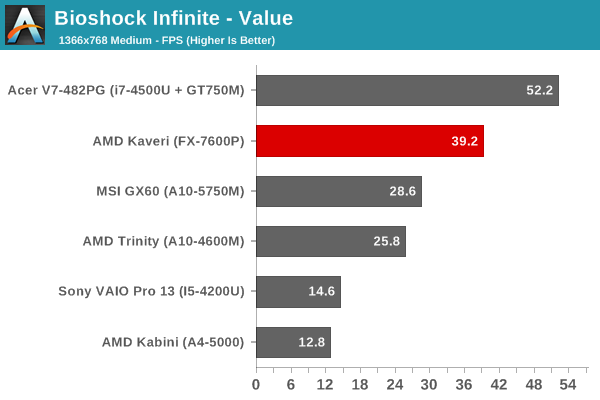
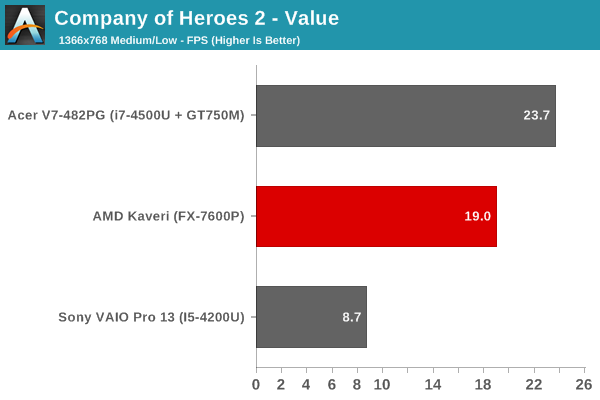
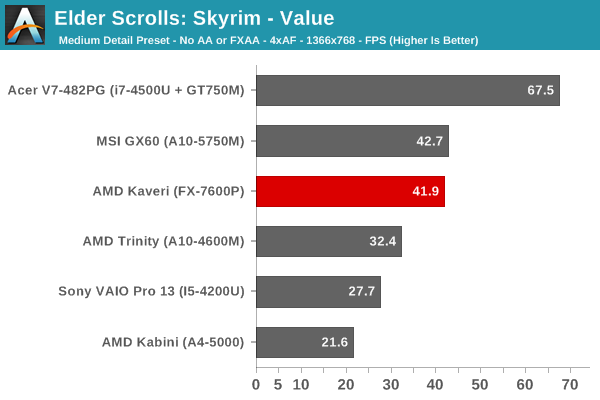
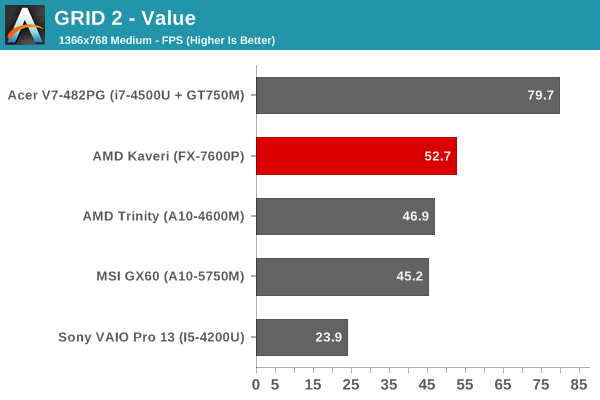

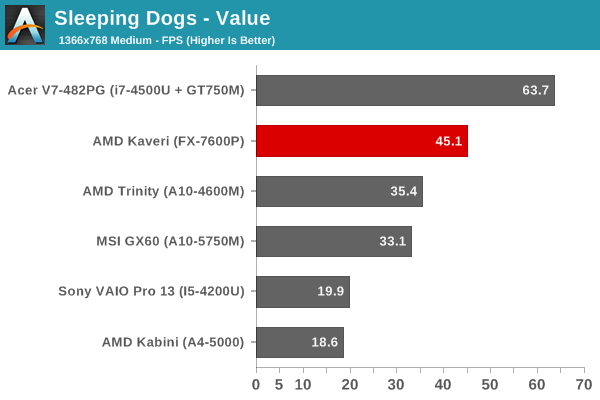
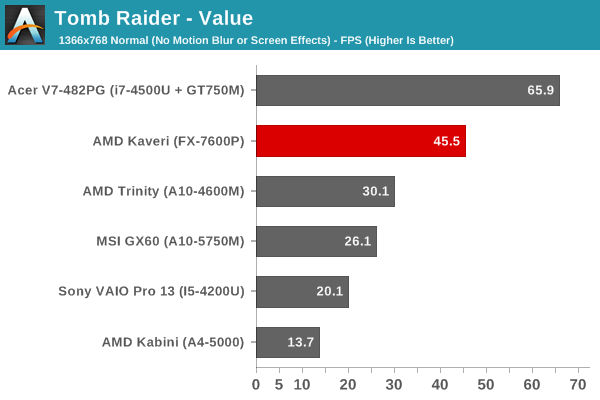
As expected, in most of the tests the Kaveri APU is able to surpass the gaming performance of every other iGPU, and in some cases it even comes moderately close to a discrete mainstream dGPU. There's a sizeable gap between the Trinity/Richland APUs and Kaveri in most of the games I tested, which is great news for those looking for a laptop that won't break the bank but can still run most modern games.
Getting into the particulars, Skyrim seems to be hitting some bottleneck (possibly CPU, though even then I'd expect Kaveri to be faster than Richland), but the vast majority of games should run at more than 30 FPS. There was one system with a pre-release Mantle driver installed that was running Battlefield 4 reasonably well at low/medium details, and with shipping laptops and drivers (and perhaps DDR3-2133 RAM) I suspect even Metro might get close to 30 FPS. Of course, we're only looking at the top performance FX-7600P here, so we'll have to see what the various 19W APUs are able to manage in similar tests.










125 Comments
View All Comments
silverblue - Thursday, June 5, 2014 - link
Each Steamroller core has two integer pipes, making four per module, as compared to Haswell's four per core. If only the module was exposed to Windows rather than each integer core, wouldn't there be a chance that single threaded workloads would be significantly boosted?aicom - Thursday, June 5, 2014 - link
Not with the current microarchitecture. The integer pipelines are statically partitioned between the cores on each module (unlike HyperThreading). It's a key aspect of what AMD calls CMT.silverblue - Thursday, June 5, 2014 - link
Yes, but I was thinking about changes to the front end. I suppose what I'm referring to is a regression but the integer cores are too weak on their own. Essentially, I was imagining what would be required to adopt a more SMT-style system and whether it'd be any sort of improvement.Meteorhead - Thursday, June 5, 2014 - link
Too bad the benchmarks were not done with 2166MHz RAM modules. Earlier Richland tests in a Hungarian magazine clearly showed that ALL games are memory bandwidth limited and FPS values 100% correlate with RAM clocks. 20% increase in RAM clock = 20% increase in FPS. I'd suspect exactly the same behavior holds for Kaveri too, specially that it's even more powerful in ALU terms.orenc17 - Thursday, June 5, 2014 - link
Why Haven't you compared it to iris or iris pro?MLSCrow - Friday, June 6, 2014 - link
They aren't comparing it to Iris or Iris Pro, because...A) Kaveri costs about half or a third of what an Intel chip costs with Iris Pro, and...
B) Iris Pro only comes on certain quad-core Intel chips in the 47W TDP range. There is no fair comparison to make.
silverblue - Saturday, June 7, 2014 - link
Point B just makes me think of The Terminator..."Iris Pro CPU in the 47W range."
"Hey, just what ya see, pal."
wumpus - Thursday, June 5, 2014 - link
The point is that a power supply may be expected to supply more than the TDP for significant portions of a second (more than enough to exhaust the input capacitors of the output switcher). Don't use TDP for electrical specs.MLSCrow - Friday, June 6, 2014 - link
Awesome name btw. I used to play a game for my TI-99 back in the early 80's called "Hunt the Wumpus".TheJian - Thursday, June 5, 2014 - link
1366x768 and these are avg fps I'm sure as no mention of mins, so don't even expect to play in this CRAP resolution without a gpu as shown. Unfortunately as these things have gotten faster, game engines have gotten more taxing. They really have gained nothing on discrete which is why those sales are staying just where they are while PC sales are down 12% last year. You still need a card to do real gaming.